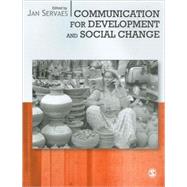
Note: Supplemental materials are not guaranteed with Rental or Used book purchases.
Purchase Benefits
What is included with this book?
| List of Tables | p. 7 |
| List of Figures | p. 8 |
| List of Boxes | p. 9 |
| List of Abbreviations | p. 10 |
| Introduction | p. 14 |
| Introduction | |
| Communication and the Persistence of Poverty: The Need for a Return to Basics | p. 31 |
| Hybrid Interactions: Human Rights and Development in a Cultural Perspective | p. 45 |
| Media Globalization through Localization | p. 58 |
| Vertical Minds versus Horizontal Cultures: An Overview of Participatory Process and Experiences | p. 68 |
| The Theoretical Underpinnings of Development Communication | |
| The Panoptic View: A Discourse Approach to Communication and Development | p. 85 |
| Threads of Development Communication | p. 96 |
| Development Communication Approaches in an International Perspective | p. 158 |
| Tracing the History of Participatory Communication Approaches to Development: A Critical Appraisal | p. 180 |
| Communication Policies, Strategies and Exemplars | |
| Communication for Development Approaches of Some Governmental and Non-Governmental Agencies | p. 201 |
| UNESCO's Contributions to Cultural Diversity and Communication for Development | p. 219 |
| Making a Difference through Development Communication: Some Evidence-based Results from FAO Field Projects | p. 232 |
| Involving People, Evolving Behaviour: The UNICEF Experience | p. 254 |
| Special Case: HIV/AIDS Campaigns | |
| Rural HIV/AIDS Communication/Intervention: From Using Models to Using Frameworks and Common Principles | p. 279 |
| Religion and HIV/AIDS Prevention in Thailand | p. 296 |
| Fighting AIDS with Edutainment: Building on the Soul City Experience in South Africa | p. 327 |
| More Complexity Added: Community Media and Conflict Resolution | |
| Making Community Media Work: Community Media Identities and Their Articulation in an Antwerp Neighbourhood Development Project | p. 347 |
| Working with Media in Areas Affected by Ethno-political Conflict | p. 374 |
| Conclusion | p. 389 |
| Bibliography and Select Readings | p. 391 |
| About the Editor and Contributors | p. 414 |
| Index | p. 421 |
| Table of Contents provided by Ingram. All Rights Reserved. |
The New copy of this book will include any supplemental materials advertised. Please check the title of the book to determine if it should include any access cards, study guides, lab manuals, CDs, etc.
The Used, Rental and eBook copies of this book are not guaranteed to include any supplemental materials. Typically, only the book itself is included. This is true even if the title states it includes any access cards, study guides, lab manuals, CDs, etc.